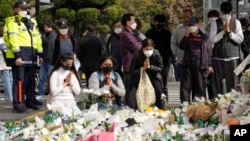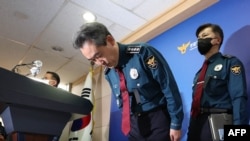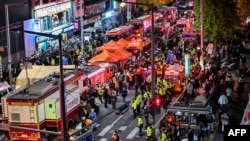South Korea's police chief acknowledged failures in handling last week's deadly Halloween crowd surge, as officials try to contain public outrage over one of the country's deadliest peacetime disasters.
An initial investigation revealed police received several emergency calls from frightened partygoers before the accident occurred late Saturday, according to Yoon Hee-keun, the commissioner general of the Korean National Police Agency.
The earliest phone call was received at 6:34 p.m. police said, adding they received 10 more calls over the next three and a half hours. The worst of the crowd surge reportedly began at around 10:15 p.m.
"The calls warned about the danger from a large crowd gathering. We judged that the [local police station's] response to the…reports was insufficient," Yoon told a news conference Tuesday.
Bowing deeply before reporters, Yoon said he feels a "heavy responsibility" for the disaster and an "infinite responsibility" for public safety. "We will do our best to prevent such a tragic event from happening again," he said.
Earlier Tuesday, the death toll from the crowd surge rose to 156 people, after a 20-year-old Korean woman was pronounced dead, Seoul officials said. Twenty-nine people remain in serious condition.
The South Korean public has begun pushing harder for answers about why police did not do more to control the crowd in the Itaewon neighborhood, where an estimated 100,000 people had gathered to celebrate Halloween.
The accident occurred in a narrow, steep alley connecting the upper and lower levels of Itaewon. With seemingly no crowd control, masses of people began pushing from both sides, with those on the bottom eventually losing their footing and getting crushed.
A bar security guard who was posted directly above the alley told VOA he saw no police patrols in the area and that officers never showed up when an earlier injury occurred at his pub.
While initial reports characterized the incident as a "stampede," many Seoul residents disagree with that characterization. The disaster, they say, was not the result of a wild, uncontrollable force, but a failure of planning.
"There was absolutely no stampede," said Cho Hee-kyoung, a professor at Seoul's Hongik University College of Law. "It was simply mechanics and physics of too many people being crowded into too small an area. If they had just the basic kind of crowd control measures in place, this wouldn't have happened."
Many are still processing the trauma. Ahn Sang-jun, a 28-year-old who was hanging out with friends in Itaewon Saturday night, was among those who administered CPR to the victims before emergency officials arrived. He says he can't stop thinking about the young woman he tried to help, who died.
"We eventually moved her to a larger road where the ambulances arrived, but they were all absolutely full and I couldn't do anything else for the victim," he told VOA. "The fact that I couldn't help more, and everything else I witnessed that night, weighs very heavily on my heart," he added.
Some police officials have said managing the crowd was more difficult because there were no event organizers.
However, South Korean President Yoon Suk Yeol said Tuesday that the focus should be on investigating the incident and preventing future disasters.
"Rather than nitpicking about whether the event had an organizer, it is the people's safety that is important, and we need to come up with thorough measures," Yoon said, adding that South Korea lagged on crowd management techniques.
"We need to leverage advanced digital capabilities such as drones to develop crowd management technology and make necessary institutional improvements," he said.
It is a delicate situation for Yoon, a conservative whose approval ratings have hovered around 30% since taking office in May. South Korea's last conservative president, Park Geun-hye, was brought down in part because of what was seen as her inadequate response to the country's last major disaster — the 2014 sinking of the Sewol ferry, which killed about 300 people, mostly high school students.
Earlier this week, South Korea's Interior and Safety Minister, Lee Sang-min, created a public uproar after appearing to suggest that police could not have prevented the disaster. On Tuesday, his ministry released a statement expressing regret over the statement.
"We will concentrate more on the accident investigation in the future," the statement said.








